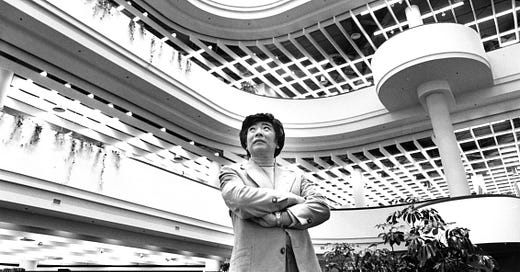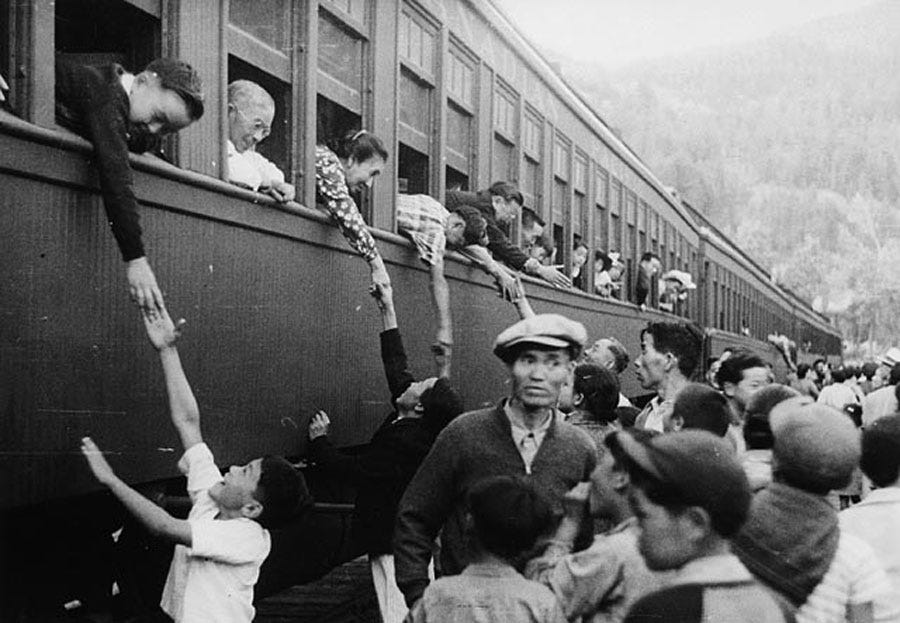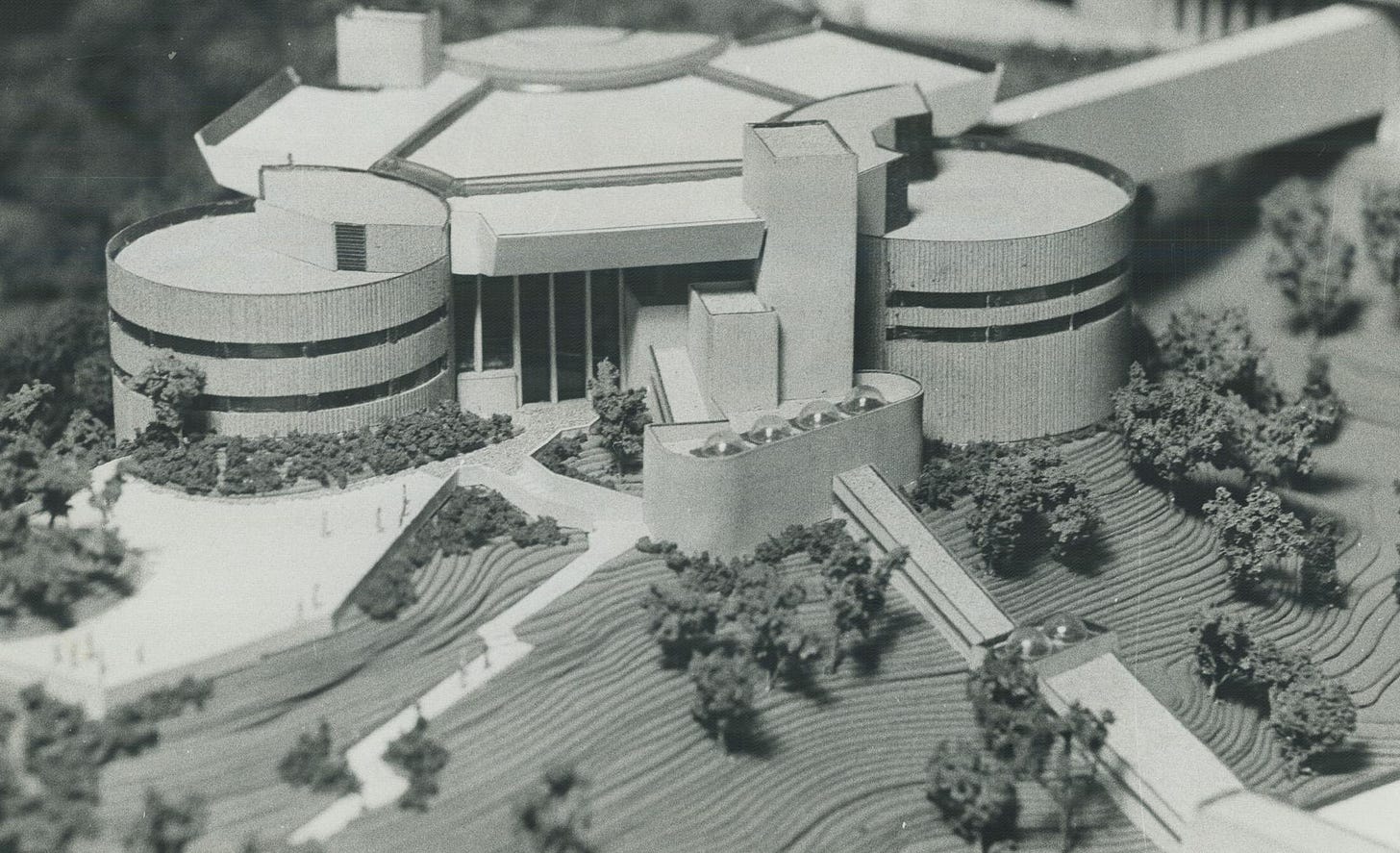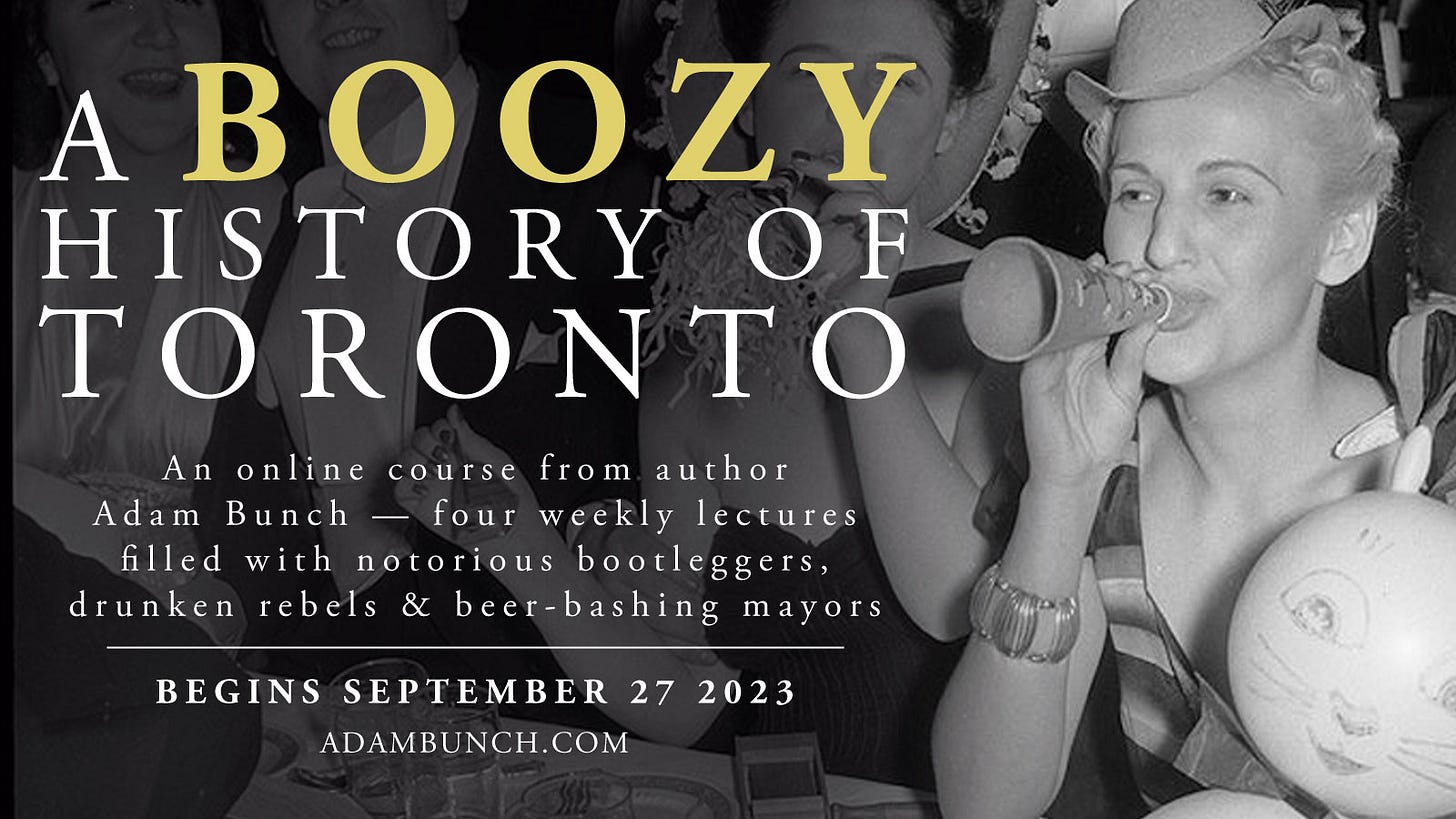The Concrete & Hope of Raymond Moriyama
Plus, the campaigns to save the Ontario Science Centre & Ontario Place, saying goodbye to Claude Cormier, and more...
When Raymond Moriyama was four years old, he built a model airplane, wound it up, and let it go. That short flight would change his life. The plane soared through the house, landing in the kitchen — right on the stove. And when the little boy climbed up on a stool to retrieve it, disaster struck. Down they went: the boy, the stool, the pot sitting on a burner… and the boiling water inside it.
Moriyama was badly burned, all down his arm and across his back. He'd be stuck in bed for the next eight months recovering. He spent a lot of that time looking out his bedroom window; his father pulled the bed up next to it. And there, outside, construction workers were erecting a new building.
The four-year-old was fascinated. "I thought it was a castle going up," he later explained. "And every once in a while, a man used to come onto the site. I thought, 'Well, that guy's really good-looking.' And when he opened these rolls of drawings, all the men would smile and nod. I thought, 'Wow, that guy's got talent.'"
He asked his father who the man was. And when he got his answer, he instantly knew what his path in life would be. "I'm going to be an architect, too."
He would go on to become one of the most celebrated designers of buildings that Canada has ever known. The Ontario Science Centre. The Toronto Reference Library. The Bata Shoe Museum. The Japanese Canadian Cultural Centre. The Scarborough Civic Centre. The North York Central Library. The pavilion in Edwards Gardens. The Canadian War Museum in Ottawa. Science North in Sudbury. The Canadian Embassy in Tokyo. You'll find his buildings all over the country — and around the world. They're deeply beloved. And that's in large part thanks to the fact that he infused these spaces with the lessons he learned in his youth.
Moriyama was born in Vancouver at the end of the 1920s. "To my mind," he remembered, "Vancouver before the war was not a very good place for Japanese-Canadians. It was a hotbed for hating Asians." In 1907, white residents had attacked their Asian neighbours. The Asiatic Exclusion League organized a march attended by ten thousand people, sparking a racist riot that lasted three days. In Japantown, businesses were besieged by the mob, windows broken, thousands of dollars in damage done, Japanese-Canadians forced to fight back and defend their neighbourhood. The federal Canadian government responded by cracking down on immigration from Asia, including a "gentlemen's agreement" with Japan that limited the number of new arrivals to just four hundred a year.
Moriyama knew the prejudice of the following decades well; he felt it throughout his childhood. But when the Second World War broke out, that discrimination reached new heights. He was twelve years old when the bombing of Pearl Harbour led to war with Japan. The Canadian government rounded up more than twenty thousand Japanese-Canadians, imprisoning its own citizens in internment camps and seizing their property.
Moriyama's father was the first in the family to go. He was a pacifist arrested by the RCMP. As the Mounties carried his dad off to a POW camp, Moriyama was given a chilling warning by one of the officers: "If we see you outside after sunset, you will be shot." Soon, the rest of the family was taken into the Rocky Mountains, imprisoned at the Slocan City internment camp along with hundreds of others. There, they were forced to live in a bug-infested horse stall. Moriyama broke down in tears when he saw it; so did his mother. "Canada went to war in defense of individual rights and democracy," he once explained, "but at home they were separating families and discriminating against all Japanese-Canadians."
It was there in the mountains that Raymond Moriyama would design his first building. It was a secret treehouse.
The twelve-year-old's project began because he hated having to shower in public at the camp. He was bullied over the scars from his burns. So, he began slipping away to swim in the glacial chill of a nearby river. "It was better than hot tears," he explained. But he was in danger every time he snuck off; the Mounties patrolled the camp. The treehouse, built with scavenged supplies, gave him a perch from which to spot anyone approaching. But it also gave him a quiet place all his own, somewhere to escape the suffering of the camp.
"That tree house, when finished, was beautiful," he later remembered. "It was my university, my place of solace, a place to think and learn."
"In my sanctuary," he added on another occasion, "I developed a new understanding of myself, of nature, of Canada and the fragility of democracy.” The thoughts and feelings he experienced there as a boy in that mountain treehouse would influence his work for the rest of his life.
After the war, many Japanese-Canadians were deported — even those born here — and the rest were banned from living on the west coast. His reunited family moved east to Hamilton, where Moriyama became the first Japanese-Canadian to attend high school in the city. And though those were hard, lean years, and he faced plenty more discrimination, he went on to study at the University of Toronto, where he'd find a mentor in architect Eric Arthur (author of Toronto, No Mean City). Then he headed to McGill for his graduate work, studying the social sciences that would inform his buildings. "Without a social consciousness," as he once put it, "without psychology or understanding people, what's architecture?"
He was still a young man when he set up his own firm and began to land the commissions that would make him famous. And he would invest them with that human-centered philosophy. His treehouse had taught him just how important buildings can be. "What I do as a person, as an architect, it's not so that it looks good on paper or in a magazine. It's not a statement of one's ego. It has to express democracy, equality, inclusion of all people, and social justice. If not, then architecture is a hollow sham."
"Architecture," he once explained, "is about life."
His buildings would be spectacular, award-winning spaces. Grand and modern titanic creations of concrete and glass. But they would also be deeply concerned with the people within; they meet us on a human scale, and they're filled with emotion. "Architecture is not just a physical building," he said. "Architecture is for people to come together."
The Toronto Reference Library gives you both a soaring atrium and nooks and crannies in which you can explore millions of books, maps, newspapers and films. The Scarborough Civic Centre — the old city hall — placed the councillors in the back, without windows, while the secretarial staff got to work in the light of the glorious atrium. (“The mayor’s window," Moriyama joked, "is low enough you can throw a brick right through it.") And when he built the Canadian War Museum in Ottawa, he insisted on interviewing people from across the country first, making sure to reflect their feelings about war and peace in the design. The building has slanted walls and strange angles, meant to unsettle visitors as they contemplate the horrors of the stories told inside it.
Horrors Moriyama knew all too well. "The treatment by the Canadian government during the war will never leave me," he explained not long ago. "After all these sixty, seventy years, I still think about it. That injustice is still there…You think that it's different today? It isn't. Canada is still filled with a lot of ignorant people."
And so, Moriyama's buildings aren't just buildings. They're reminders of Canada's disturbing past, the challenges of our present, and an optimistic roadmap toward a better future. They're all descendants of that treehouse he built when he was twelve. "It got me out of despair and hate," he said. "And I thought, 'Well maybe I could do something quite positive. Maybe, as an architect, I might be able to contribute.' And that gave me a flicker of hope for the future… I clung to my hope… You fight back and try to improve it: your country, your community."
He spent the rest of his life working to turn that hope into reality. And when he passed away earlier this month, he left behind that lifetime of buildings — museums and libraries, high schools and civic centres that have won a place in the hearts of generations of Canadians.
But now, two of his greatest works are under threat — both of them here in Toronto.
The Japanese Canadian Cultural Centre was his first major building. It opened in 1963, while the Second World War was still a relatively fresh memory. The community was still recovering from the abuses they'd suffered; the project was meant to unite them, a place filled with hope for the future. "As a young architect," Moriyama explained, "I said, 'What can I do to make Canada a better place?' My dream was to bring the community together." Without the money to fully fund the construction up front, dozens of families from that community mortgaged their own homes in order to bring the project to life. "Seventy people signed their lives away," he remembered, "and this is not too much after the war; people had absolutely no money. If the mortgage wasn't paid on time, the seventy people would have gone under. And the community, too."
So, there are few buildings in our city imbued with more meaning than the Japanese Canadian Cultural Centre. It is, according to the Globe's architecture critic Alex Bozikovic, "one of the best buildings in Toronto, artful Modern architecture that captures the spirit of its time and its users." But now, the building has been sold to a private developer who plans to demolish much of it while building a condo tower, leaving only a few fragments. "This is an unacceptable outcome for an important work of architecture that holds great social significance," Bozikovic argues. "It must not be allowed to proceed."
And then there's the Ontario Science Centre.
When it opened in 1969, it was among the first museums in the world to adopt a hands-on approach with visitors, pioneering a new way of connecting with people, using fun and visceral experience to educate. Moriyama gave it a spectacular home, a futuristic complex that descends into the ravine of the West Don River, connected by bridges and escalators. It has earned a joyful place in the childhood memories of countless Torontonians. And it has helped inspire hundreds of museums to follow a similar approach.
Today, it's under threat for the most cynical of reasons. The Ford government plans to shut it down and move it to the waterfront, forcing it into a smaller space in order to help justify handing over much of the public park at Ontario Place to a private spa on a 95-year lease while spending hundreds of millions of public dollars to build a parking lot for it. And as part of those plans, another piece of Japanese-Canadian history will be displaced. The Goh Ohn Bell stands in an award-winning shelter designed by Moriyama. It was unveiled half a century ago to commemorate the centennial of Japanese settlement in Canada. But it stands in the place the spa is supposed to be built — so if the provincial government gets its way, it will be forced to move, while hundreds of trees are felled and much of Ontario Place transformed into a private space at great public expense.
"I tried to work with honesty and integrity," Moriyama once said. "The greed is conquering too many of us. People end up just doing things for the money. There's more to life than just making money. My life has to mean something."
It did. He has left us with a legacy of concrete and hope. Now, what with do with it is up to us.
The “Save Ontario’s Science Centre” and “Ontario Place For All” campaigns have lots of suggestions for how you can join the effort to save the sites — including petitions, letter writing, and a rally being held this Saturday afternoon in response to the government’s annoucement they’'ll begin cutting down trees at Ontario Place soon.
I got most of my quotes for this piece from a wonderful documentary, “Magical Imperfection: The Life and Architecture of Raymond Moriyama”, which you can watch for free on the TVO website here. (Now, let’s hope they give their employees a fair deal.) Alex Bozikovic shares his remembrance of the architect in the Globe and Mail here, with a call to “save his legacy from the small thinking of our time.”
Free Beer! And The Boozy History of Toronto…
I’m bringing back one of my most popular online courses — and this time it comes with free beer!
Alcohol has always been a dramatic part of life in Toronto — from the days of colonial treachery to modern debates over drinking in parks. In this four-week online course, we'll meet drunken rebels, beer-bashing mayors, notorious bootleggers, and alcoholic politicians. We'll witness booze-soaked murders, prohibition-era shootouts, and the kidnapping of one Canada's wealthiest brewers — plus, the bitter fight over whether drinking should be allowed at all. To truly understand Toronto, it helps to understand how this city has been shaped by centuries of people getting drunk.
The course is being sponsored by the wonderful people at Great Lakes Brewery, who got in touch asking if they could give the students free beer! Of course I said yes! So, if you’re logging in from Toronto, you’ll get a grand total of eight free beers to go along with the course — two for each class. (And if you’d like to do a little of your own research ahead of time so you know what kind of tasty beer you’re in for, you can check out the Great Lakes Brewpub at 11 Lower Jarvis or find them on offer in bars and restaurants around the city.)
The course begins September 27 and runs for four Wednesday nights. And as always, paid subscribers to the newsletter get 10% off!
A quick note of thanks to all of you who support The Toronto History Weekly as a paid subscriber… and a little reminder that if your credit card has expired since you first signed up, your subscription might have lapsed — it has happened to lots of long-term supporters and you might not have noticed. So if you’d like to continue your support, you might have to update your info!
The Toronto History Weekly is a ton of work and I’m only able to offer it for free thanks to those of you who support it with a few dollars a month. Only about 4% of readers have made the switch so far, which basically means that you’re giving the gift of Toronto history to 25 other people — in addition to getting perks like 10% off my online courses. If you haven’t already made the switch, you can do it by clicking right here:
QUICK LINKS
The best of everything else that’s new in Toronto’s past…
SAD LANDSCAPE ARCHITECT NEWS — Raymond Moriyama isn’t the only person we’ve lost this month who left us with a lasting legacy of wonderful designs. Claude Cormier was behind some of the most whimsical and beloved new places in Toronto, including Love Park, Sugar Beach, HTO Beach, and the dog fountain in Berczy Park. His Wellington Cat Promenade is due to open before long, too. He passed away this week at the age of 63. Read more.
52% OF THE POPULATION NEWS — Myseum has unveiled their latest project, which I know they’ve been hard at work on for months now. It’s called The 52, a multi-year project that involves commissioning two dozen playwrights to compose 52 monologues, one for each of 52 women among those who’ve helped change our city. They include everyone from Emma Goldman to Jackie Shane to Mary Ann Shadd to Frances Loring to Bianca Andreescu. The 52 will have its big premiere as part of Nuit Blanche this weekend. Learn more.
NOT BORING NEWS — If you’re reading this newsletter, I imagine you’re not among those who think Toronto’s history is boring. Jamie Bradburn writes a little bit about that myth and how silly it is in his newsletter this week, using a century-old newspaper column as his jumping off point. Read more.
RUINS NEWS — Construction of the new Ontario Line subway has revealed some of the hidden history of Queen Street, as Sean Galbraith shares on Twitter:
(Click to open on Twitter.)
EXPLORING MOORE PARK NEWS — Historian Lorraine Tinsley got in touch this week to tip me off to self-guided walking tour she’s developed with Sean Marshall for the Moore Park Residents Association. It gives you “a brief history of the area, with opportunities to explore deeper by strolling through lush ravines.” Check it out.
TORONTO HISTORY EVENTS
MISADVENTURE ON THE HUMBER
September 21 — 7:30pm — Lambton House — Heritage York
Heritage walk and film premiere. “August, 1968. In the lovely west end neighbourhood of Warren Park, four girls and a dog were enjoying one of the last days of summer vacation. While swimming in the river, a sudden storm hit, stranding them on the abutments. This event — with a short film and talk — recounts the events of that day, with the now-adult people who have lived to tell the tale.”
TORONTO’S MAYORS FROM MUDDY YORK TO MEGA CITY
September 21 — 7:30pm — Montgomery’s Inn — The Etobicoke Historical Society
“Frank Nicholson will help us see the history of Toronto unfold through the careers of some of the sixty-five chief magistrates the city has had since being incorporated in 1834, including our first mayor, William Lyon Mackenzie, the leader of the Rebellion of 1837, and Mel Lastman, who oversaw the amalgamation of the city and its suburbs creating Megacity, our current city, twenty-five years ago.”
Exclusively for members of the Etobicoke Historical Society; an annual membership is $25.
ANNUAL GOVERNOR SIMCOE WALKING TOUR
September 23 — Part 1: 9:30am & Part 2: 1pm — Swansea Historical Society
“As in past years, this FREE guided walking tour will retrace a portion of Simcoe’s 1793 expedition up the Toronto Carrying Place portage route. As in past years, Part 1 of the tour will start at 9:30 am at the Rousseau plaque (8 South Kingsway, beside the Petro Canada station), heading north, mainly along Riverside Drive, and finishing near Bloor Street. After a break for lunch on Bloor Street, Part 2 will start at 1:00 pm at the Alex Ling Fountain (north-west corner of Bloor and Jane Streets), and then head farther north, mainly following residential streets a short distance east of the Humber River. Participants are free to join or leave the walk at any point along the route.”
Free!
ST. JOHN’S NORWAY CEMETERY WALK
September 23 — 1pm — Meet at the north-west corner of Woodbine & Kingston Road — The Beach & East Toronto Historical Society
A walking tour with Gene Domagala. “Celebrating the 170th anniversary of the cemetery and St. John’s Norway Anglican Church.”
Free!
THE 52
September 23 — Dusk to dawn — 229 Richmond Street West — Myseum
“Women currently make up 52% of the population in Toronto. Join us as we bring their stories to life. This impact-filled multi-year project celebrates the myriad of ways women have contributed to various facets of city life – in art, culture, politics, sports, technology, business, and more. To tell these important stories, this project has commissioned 24 exemplary playwrights to write 52 monologues – one for each transformational woman on our list. This work will premiere as a participatory performance on September 23 as part of Nuit Blanche 2023.”
Free!
THE 130 YEAR HISTORY OF AN EAST TORONTO HOUSE
September 27 — 7pm — The Beaches Sandbox — The Beach & East Toronto Historical Society
“The Beach & East Toronto Historical Society in partnership with The Beaches Sandbox presents Canadian golf historian Ian Murray with Paul Nicosia. The 130 years history of an East Toronto house and its remarkable family of stonecutters and golfers.”
Free!
Free!
MR. DRESSUP TO DEGRASSI: 42 YEARS OF LEGENDARY TORONTO KIDS TV
Until September 23 — Wed to Sat, 12pm to 6pm — 401 Richmond — Myseum
“The TV shows of your childhood hit closer to home than you might think. From 1952 to 1994, Toronto was a global player in a golden era of children’s television programming. For over four decades, our city brought together innovative thought leaders, passionate creators and unexpected collaborations – forming a corner of the television industry unlike any other in the world. Toronto etched itself into our collective consciousness with shows like Mr. Dressup, Today’s Special, The Friendly Giant, Polka Dot Door, Degrassi, and more. Journey through Toronto’s heyday of children’s TV shows in this playful exhibition.”
Free!
TORONTO AS COMMUNITY: FIFTY YEARS OF PHOTOGRAPHS
October 5 — West Toronto Junction Historical Society
“Vincenzo Pietropaolo’s presentation on his new book ‘Toronto as Community: Fifty Years of Photographs.’ Those who attended Vince’s presentation of photographs in October 2022 on ‘The Stockyards Then and Now’ will be thrilled to have another session with him and his wonderful photos and commentaries.”
SPACIOUSNESS
Various dates until Oct 7 — 7pm — Fort York
“Spaciousness is a compelling new theatrical experience that offers a tour like no other. Be transported to the past to encounter a multitude of characters who bring to life expansive stories of love, life, and loss during the War of 1812. Then be brought back to present day with a story of surviving conflict that encourages us towards peace. Traverse the grounds of Fort York and meet a cast of characters while travelling from one historic building to another, becoming immersed in stories of life during wartime.”
$30
THE DON: INMATES, GUARDS, GOVERNORS & THE GALLOWS
October 19 — 7:30pm — Montgomery’s Inn — Etobicoke Historical Society
“Join writer and researcher Lorna Poplak as she presents the facts behind the Don Jail’s location and construction, and shares tales about inmates, guards, governors, gangs, officials, and even a pair of ill-fated lovers whose doomed romance unfolded in the shadow of the gallows. The illustrated talk will highlight the Don’s tumultuous descent from palace to hellhole, its shuttering and lapse into decay, and its astonishing modern-day metamorphosis.”
Members only; an annual membership is $25.
A NIGHT AT THE MUSEUM
October 20 — 7pm — Toronto’s First Post Office — Town of York Historical Society
“Join Toronto’s First Post Office & special guest, Richard Fiennes-Clinton, as we experience the museum after hours with a presentation on the traditions surrounding the Victorian culture of death and dying & the spread of spiritualism in Toronto with a look at the rising popularity of capturing ghosts on film! You’ll also craft your own Victorian mourning wreath to take home and display in plenty of time for Hallowe’en. All materials are included in the ticket price.”
$11.98 for members; $17.31 for non-members.








